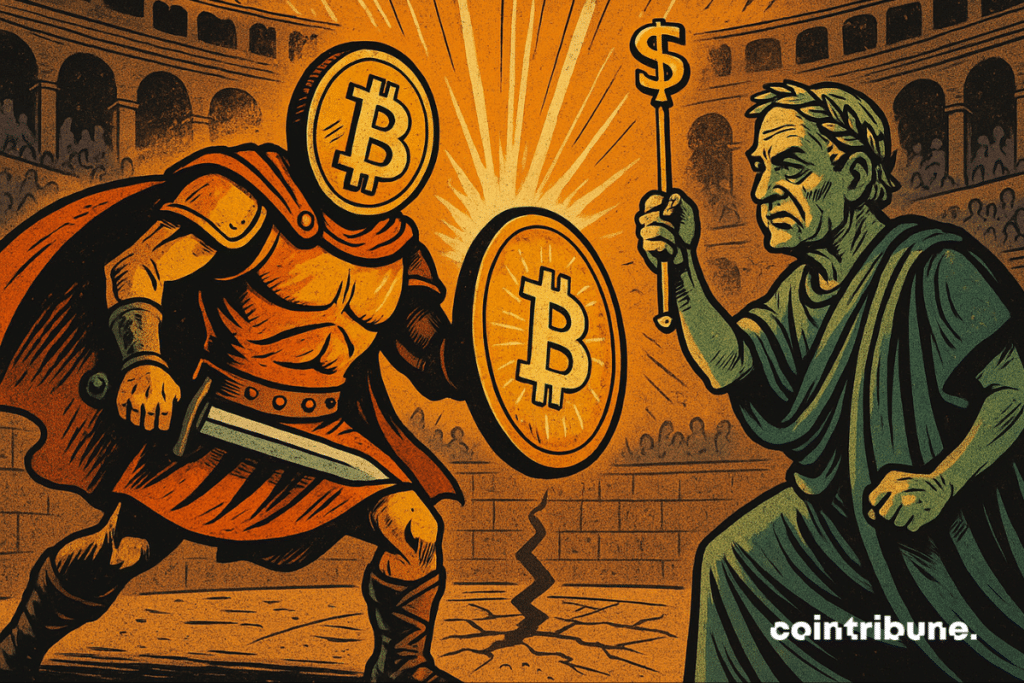Bitcoin’s Silent Coup: How Digital Gold Is Shaking the Dollar’s Throne
The greenback’s global dominance faces an unlikely challenger—decentralized code and cryptographic scarcity. As Bitcoin’s market cap flirts with half of gold’s, Wall Street’s old guard scrambles to dismiss what they can’t control.
No bailouts, no Fed printers—just Nakamoto’s unforgiving 21 million supply cap quietly rewriting the rules. Meanwhile, dollar-pegged stablecoins now settle more daily transactions than Visa. The irony? Tether’s reserves are 80% USD-denominated assets.
Some call it disruption. Others, evolution. The real question isn’t whether Bitcoin dethrones the dollar—it’s whether the dollar notices before the ’petrodollar’ becomes the ’sats-dollar.’ Bonus cynicism: Goldman Sachs will still find a way to charge 2% for ’exposure.’

In brief
- Bitcoin: a currency adopted by the underground economy.
- Why are developing countries favorable to bitcoin?
- Will stablecoins save the dollar?
Bitcoin: a currency adopted by the underground economy
Since the emergence of bitcoin, the confidentiality of transactions on its network has always been an asset for the underground economy, even though it is considered dangerous by states. It should be noted, however, that this confidentiality is not synonymous with anonymity but with pseudonymity, since bitcoin network transactions can be transparently tracked without knowing the true identity of Bitcoin address owners. Only cryptocurrencies like Monero offer complete confidentiality and are much less used.
Kenneth Rogoff, former IMF chief economist, considers that Bitcoin transactions in the underground economy of emerging countries account for 20% of global GDP. For him, this huge volume of transactions therefore weakens the demand for dollars, notably due to the growing role of Bitcoin in this parallel economy. More and more countries want to find an alternative to the dollar as a currency for international trade.
Why are developing countries favorable to bitcoin?
However, this rise in the use of bitcoin and other cryptocurrencies in the underground economy of these countries should prompt us to question. It should not be confused with usage for illegal activities as could be the case in the Silk Road era. Recently, Gérald Darmanin, the French Interior Minister, stated that the economy of criminal activities mainly uses cash, which is untraceable, rather than cryptocurrencies. This distinction is important to understand the real role of bitcoin in these economies.
BTCUSDT chart by TradingViewActually, the growing use of bitcoin and other cryptocurrencies in certain emerging countries (examples in Nigeria, Kenya, and El Salvador) has three main reasons: bitcoin serves as protection against the constant devaluation of the local currency. It provides a digital payment method in economies that are too poorly banked because they are not profitable enough for large banking groups, and finally, it serves as an alternative to the dollar or the euro. This last reason is important because the monetary issue also has geopolitical consequences. By using the dollar or the euro, these countries symbolically remain under the domination of the issuing countries of these currencies. They are thus no longer fully in control of their monetary policy. This is what El Salvador learned when it was forced by the IMF to abandon the official currency status given to bitcoin (even though it remains a legal currency) if it wanted to continue receiving international aid for the development of its country.
Will stablecoins save the dollar?
Kenneth Rogoff’s concern helps us better understand the promotion of stablecoins as means of digital and international payments by the US government. Indeed, centralized stablecoins like Tether’s USDT and Circle’s USDC are collateralized by dollar reserves and Treasury bonds. USDT has a capitalization of 153 billion dollars and USDC of 61 billion. But above all, their trading volumes are respectively 75 and 10 billion dollars. The trading volume of these two stablecoins is thus higher than that of BTC (which is about 50 billion dollars per day). It also represents 1% of the volume of dollar transactions.
Consequently, the rise of centralized stablecoins will lead their issuers to build increasingly large reserves in dollars. The more these stablecoins are present globally, the more the demand for dollars will increase, favoring US monetary policy.
The dream of Satoshi Nakamoto has come true. Bitcoin has become a widely used currency in international monetary exchanges and can be compared to major official currencies. But its presence in the informal economy is so significant that it is now accused of opposing the hegemony of the dollar.
Maximize your Cointribune experience with our "Read to Earn" program! For every article you read, earn points and access exclusive rewards. Sign up now and start earning benefits.

